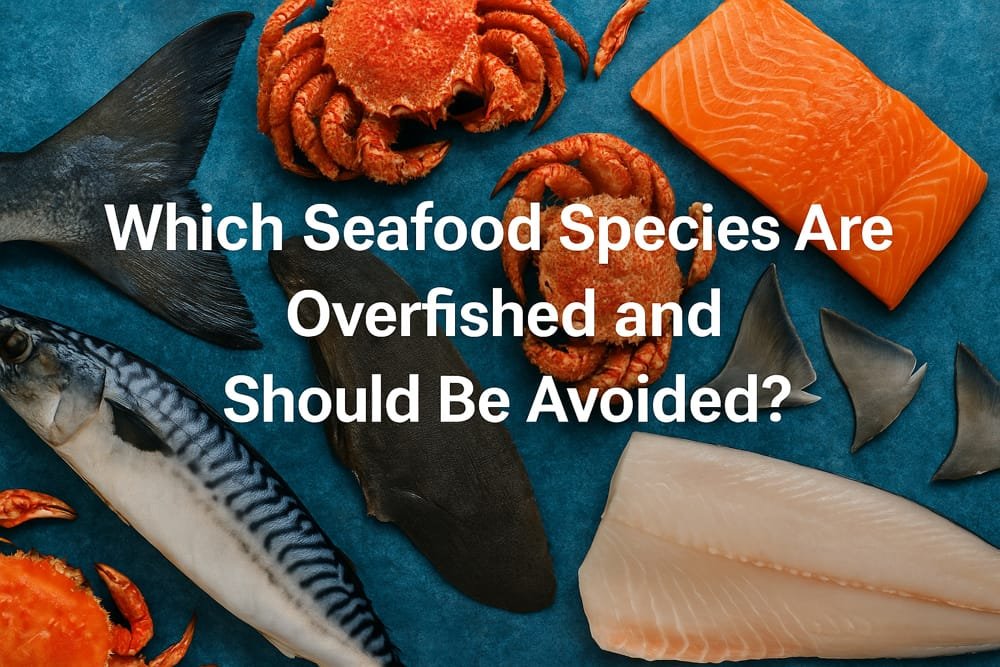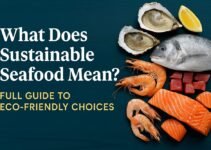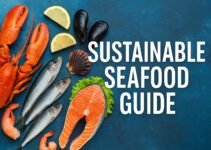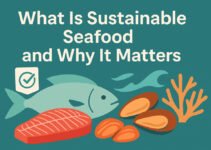Overfishing is a severe global crisis that threatens marine ecosystems and future food security. According to the Food and Agriculture Organization (FAO), over 35% of the world’s fish stocks are currently overfished. This depletion affects not only biodiversity but also millions of people who rely on seafood as their primary protein source. Understanding which seafood species are overfished and avoiding their consumption is a direct way consumers can contribute to ocean preservation. This guide provides a clear, factual overview of the most critically overfished species, their ecological impacts, and how you can make informed, sustainable seafood choices.
Contents
- 1 What Does It Mean When a Seafood Species Is Overfished?
- 2 Which Seafood Species Are Currently Overfished Globally?
- 3 Which Seafood Species Are Overfished in the United States?
- 4 How Does Overfishing Affect Marine Ecosystems and Food Security?
- 5 How Can You Identify Overfished Seafood at Markets and Restaurants?
- 6 What Are the Best Sustainable Alternatives to Overfished Species?
- 7 How Can You Support Sustainable Fishing Practices?
What Does It Mean When a Seafood Species Is Overfished?
Overfishing occurs when the harvest rate of a species exceeds its natural reproductive capacity. This results in declining populations that cannot replenish fast enough to meet ongoing demand. The FAO defines overfishing as a condition where fish stocks fall below the level capable of producing maximum sustainable yield.
How Do Experts Measure Overfishing Levels?
Experts assess overfishing using biological reference points like Spawning Biomass and Fishing Mortality Rate.
- Spawning Biomass (SB): Represents the total weight of sexually mature fish in a population. When SB drops below 20% of its historical maximum, a species is classified as overfished.
- Fishing Mortality Rate (F): Measures the proportion of a fish population removed by fishing. If F consistently exceeds the Maximum Sustainable Yield (MSY) threshold, overfishing is occurring.
Reliable organizations like the International Union for Conservation of Nature (IUCN) and NOAA Fisheries monitor these metrics to classify species status.
What Are the Primary Causes of Overfishing Worldwide?
There are 5 primary causes of overfishing globally:
- Industrial-Scale Fishing: High-capacity fleets use trawlers and longlines that harvest massive quantities unsustainably.
- Bycatch Waste: Non-target species like sharks, turtles, and dolphins are unintentionally captured and discarded.
- Illegal, Unreported, and Unregulated (IUU) Fishing: This accounts for up to 26 million tons of fish caught annually without oversight.
- High Consumer Demand: Popularity of species like tuna and salmon drives overexploitation.
- Weak Fisheries Management: Insufficient regulations and poor enforcement allow unsustainable practices to continue unchecked.
Which Seafood Species Are Currently Overfished Globally?
At least 10 high-demand species are critically overfished according to the IUCN Red List and FAO data. These include both commercial favorites and lesser-known species vital to ecosystem balance.
Why Are Bluefin Tuna Populations Critically Endangered?
Bluefin tuna populations are critically endangered due to high market demand and delayed maturity rates.
- The average Atlantic bluefin tuna takes 8 to 12 years to reach reproductive maturity, making recovery slow.
- Despite strict quotas, illegal fishing persists, particularly in the Mediterranean Sea.
- In 2023, the IUCN reaffirmed that the Atlantic Bluefin Tuna (Thunnus thynnus) remains endangered, with spawning biomass at just 18% of historical levels.
What Makes Atlantic Cod One of the Most Overexploited Species?
Atlantic cod has become one of the most overexploited species due to decades of industrial fishing and ecosystem mismanagement.
- In the early 1990s, the Northwest Atlantic cod stock collapsed, leading to a fishing moratorium in Canada in 1992, which displaced over 30,000 workers.
- Cod populations have not recovered significantly since, remaining at only 5–10% of historical biomass levels.
- Key factors include slow growth rates, late maturity at around 5–7 years, and continued bycatch even after commercial fishing bans.
Despite conservation efforts, climate change further disrupts their recovery by altering ocean temperatures and prey availability, particularly in the Gulf of Maine.
Is the Chilean Sea Bass Still Under Overfishing Pressure?
Yes, Chilean sea bass—also known as Patagonian toothfish—remains under significant overfishing pressure despite international regulations.
- This species became a luxury seafood item in the 1990s, leading to skyrocketing demand.
- The species is slow-growing, with individuals taking up to 13 years to reproduce, making recovery efforts extremely challenging.
- According to the Commission for the Conservation of Antarctic Marine Living Resources (CCAMLR), up to 50% of the Chilean sea bass trade has historically been linked to illegal fishing operations.
Today, while some fisheries are certified sustainable by the Marine Stewardship Council (MSC), illegal and unregulated fishing activities still threaten wild populations, particularly in remote areas of the Southern Ocean.
Why Are Orange Roughy Stocks Unable to Recover?
Orange roughy stocks remain unable to recover due to their exceptionally slow growth and reproductive cycles.
- Orange roughy can live up to 150 years and do not reach sexual maturity until around 30 years of age.
- Heavy industrial fishing during the 1980s and 1990s depleted populations before scientists fully understood their biology.
- The IUCN classifies orange roughy as vulnerable, with some regional populations reduced by over 90%.
Despite strict quotas, deep-sea trawling continues to damage their spawning grounds, further delaying recovery efforts. The long lifespan and low reproductive output mean that even minor fishing pressures have lasting population impacts.
Are Sharks and Rays Facing Extinction Due to Overfishing?
Yes, overfishing is the primary driver of extinction risk for many shark and ray species.
- Over 37% of shark and ray species are now classified as endangered, according to the IUCN Red List.
- Demand for shark fins, particularly for shark fin soup, has resulted in the killing of an estimated 100 million sharks annually.
- Key species at critical risk include the Scalloped Hammerhead (Sphyrna lewini) and Giant Manta Ray (Mobula birostris), both listed as endangered.
Sharks and rays play a vital role in maintaining healthy marine ecosystems as apex and mesopredators. Their population collapse leads to cascading effects throughout the food chain, destabilizing entire marine habitats.
Which Seafood Species Are Overfished in the United States?
The United States faces overfishing challenges for at least 15 commercially important species, according to NOAA Fisheries. These species are critical to regional economies but remain under severe pressure despite management plans.
What Is the Overfishing Status of Red Snapper in the Gulf of Mexico?
Red snapper in the Gulf of Mexico remains under overfishing pressure despite regulatory measures.
- Between 1950 and 1980, aggressive commercial harvesting reduced red snapper stocks to less than 15% of sustainable levels.
- Current rebuilding plans aim for full recovery by 2032, but illegal harvesting and bycatch continue to slow progress.
- The species takes 6–7 years to reach maturity, further delaying replenishment.
The Gulf of Mexico Fishery Management Council has set strict annual catch limits, but recreational fishing often exceeds these quotas, complicating restoration efforts.
Are American Lobster Populations at Risk from Overharvesting?
American lobster populations are at localized risk, particularly in southern New England waters.
- In the Gulf of Maine, populations remain stable, but warming waters threaten habitat suitability.
- The southern New England stock has declined by over 75% since the late 1990s.
- Rising sea temperatures above 20°C (68°F) have significantly increased lobster mortality rates.
Climate change amplifies overfishing risks, pushing lobsters into northern habitats where fishing regulations are less established. NOAA classifies the southern New England stock as “depleted,” with no immediate recovery in sight.
Why Is Atlantic Salmon from the Wild No Longer a Sustainable Choice?
Wild Atlantic salmon is no longer a sustainable choice due to near-total population collapse.
- In the United States, wild Atlantic salmon are listed as endangered under the Endangered Species Act.
- Fewer than 10,000 adult salmon return annually to U.S. rivers, a dramatic decline from historical runs exceeding 500,000.
- Overfishing at sea, habitat destruction from dams, and competition with farmed salmon have driven the species toward extinction in the wild.
Today, nearly all Atlantic salmon available in markets and restaurants is farm-raised. While certified sustainable aquaculture options exist, wild Atlantic salmon fisheries remain closed, and recovery efforts focus solely on habitat restoration.
How Does Overfishing Affect Marine Ecosystems and Food Security?
Overfishing disrupts marine ecosystems by altering predator-prey dynamics and depleting critical species needed for ecological balance. It also threatens food security for over 3 billion people who depend on seafood as their primary protein source.
What Are the Economic Impacts of Overfishing on Coastal Communities?
Overfishing causes significant economic losses for coastal communities that rely on fishing for their livelihoods.
- The World Bank estimates that overfishing costs the global economy $83 billion annually in lost potential revenue.
- In the U.S., the collapse of the Atlantic cod fishery in the 1990s led to over 30,000 job losses.
- Developing nations are particularly vulnerable, where small-scale fisheries support up to 60% of local employment.
Long-term depletion of fish stocks forces communities to abandon traditional livelihoods, increases poverty levels, and creates a reliance on imported food sources, further destabilizing local economies.
How Does the Decline of Predator Species Disturb Marine Food Chains?
The decline of predator species like sharks and tuna destabilizes marine food chains, leading to trophic cascades.
- When apex predators decline, populations of smaller fish and invertebrates increase unchecked, disrupting ecosystem balance.
- For example, reduced shark populations have led to an overabundance of mid-level predators like rays, which in turn decimate shellfish populations critical to both ecosystems and human economies.
- This imbalance negatively impacts coral reef health and the productivity of coastal habitats, such as seagrass beds and mangroves.
Marine ecosystems rely on stable predator-prey relationships to maintain biodiversity and resilience against environmental changes.
How Can You Identify Overfished Seafood at Markets and Restaurants?
Identifying overfished seafood requires understanding sustainability certifications and asking the right questions at the point of purchase.
Are There Certification Labels That Indicate Sustainable Seafood?
Yes, there are 3 globally recognized certifications for sustainable seafood:
- Marine Stewardship Council (MSC): Indicates wild-caught seafood from well-managed fisheries.
- Aquaculture Stewardship Council (ASC): Focuses on responsibly farmed seafood.
- Best Aquaculture Practices (BAP): Covers environmental and social responsibility in aquaculture.
Always check for these labels when purchasing seafood products, both fresh and frozen. Certified products ensure traceability and adherence to strict sustainability standards.
What Questions Should You Ask Your Seafood Supplier?
Ask the following 4 key questions to ensure the seafood you buy is not overfished:
- Is this seafood wild-caught or farm-raised?
- If wild-caught, what fishing method was used?
- Is this product certified by MSC, ASC, or BAP?
- Where was this seafood sourced from?
Responsible suppliers should provide transparent answers. If they cannot, it is safer to avoid the purchase to reduce the risk of contributing to overfishing.
What Are the Best Sustainable Alternatives to Overfished Species?
Choosing sustainable seafood alternatives helps reduce pressure on overexploited species and supports healthier marine ecosystems. The key is to select species that are abundant, fast-growing, and well-managed under certified sustainability programs.
Which Seafood Species Are Certified as Sustainable by the MSC?
The Marine Stewardship Council (MSC) certifies over 400 fisheries worldwide as sustainable.
- Examples of certified wild-caught alternatives include Alaskan wild salmon, Pacific halibut, and U.S. Atlantic scallops.
- These species have strong population management plans and minimal bycatch risks.
- The MSC blue label ensures that products meet rigorous environmental and traceability standards.
By purchasing MSC-certified seafood, consumers directly support fisheries that protect marine environments and promote stock recovery.
How Can Farm-Raised Seafood Contribute to Sustainability?
Farm-raised seafood can contribute to sustainability when produced under responsible aquaculture practices.
- The Aquaculture Stewardship Council (ASC) certifies farms that minimize pollution, prevent disease outbreaks, and avoid using wild fish as feed.
- Sustainable farmed options include tilapia, mussels, oysters, and barramundi, which have low environmental impact and efficient feed conversion rates.
- Filter-feeding species like mussels and oysters even improve water quality by removing excess nutrients from coastal waters.
Choosing certified farmed seafood helps meet global protein demand while reducing reliance on wild fish stocks.
Are Invasive Species Like Lionfish a Sustainable Seafood Choice?
Yes, consuming invasive species like lionfish offers a sustainable and eco-friendly alternative.
- Lionfish populations in the Atlantic and Caribbean have exploded due to a lack of natural predators, causing severe damage to coral reefs and native fish populations.
- Harvesting and consuming lionfish helps control their spread and protects local ecosystems.
- Lionfish is a versatile, mild-flavored fish rich in protein and omega-3 fatty acids.
Several coastal initiatives actively promote lionfish harvesting for culinary use, turning an environmental problem into a sustainable food source.
How Can You Support Sustainable Fishing Practices?
Consumers play a vital role in promoting sustainable fishing by making informed purchasing decisions and advocating for stronger environmental policies.
What Organizations Are Leading Efforts to Combat Overfishing?
Five major organizations are at the forefront of global efforts to combat overfishing:
- Marine Stewardship Council (MSC) – Certifies sustainable wild-caught seafood.
- Aquaculture Stewardship Council (ASC) – Sets responsible standards for farm-raised seafood.
- Oceana – Advocates for science-based fisheries management policies worldwide.
- Seafood Watch (Monterey Bay Aquarium) – Provides science-backed consumer guides for sustainable seafood.
- World Wildlife Fund (WWF) – Partners with fisheries and retailers to improve seafood sustainability practices.
Supporting these organizations through donations or by following their buying recommendations helps drive systemic change in the global seafood industry.
How Can Your Purchasing Decisions Influence the Seafood Industry?
Every purchase you make sends a clear signal to the seafood industry about consumer demand for sustainability.
- Prioritize seafood with MSC, ASC, or BAP certifications.
- Choose sustainable alternatives like Alaskan wild salmon, U.S. Atlantic scallops, and farmed mussels instead of overfished species.
- Reduce consumption of high-risk species such as bluefin tuna, orange roughy, and Chilean sea bass.
When enough consumers make informed choices, market dynamics shift, encouraging producers to adopt more responsible practices. Over time, this collective action can lead to healthier oceans and more secure global food supplies.
By making mindful decisions today, you help ensure that seafood remains abundant and available for future generations. Take action now by learning which seafood species are highest in omega-3 to balance nutrition with sustainability.



